By ECLC Staff July 15, 2017
In June 2017 students from Denmark and Germany went on a two-day excursion to Confucius’ hometown Qufu in Shandong province. Below you will find three accounts from students who took part in the excursion as well as five Chinese essays on the excursion.
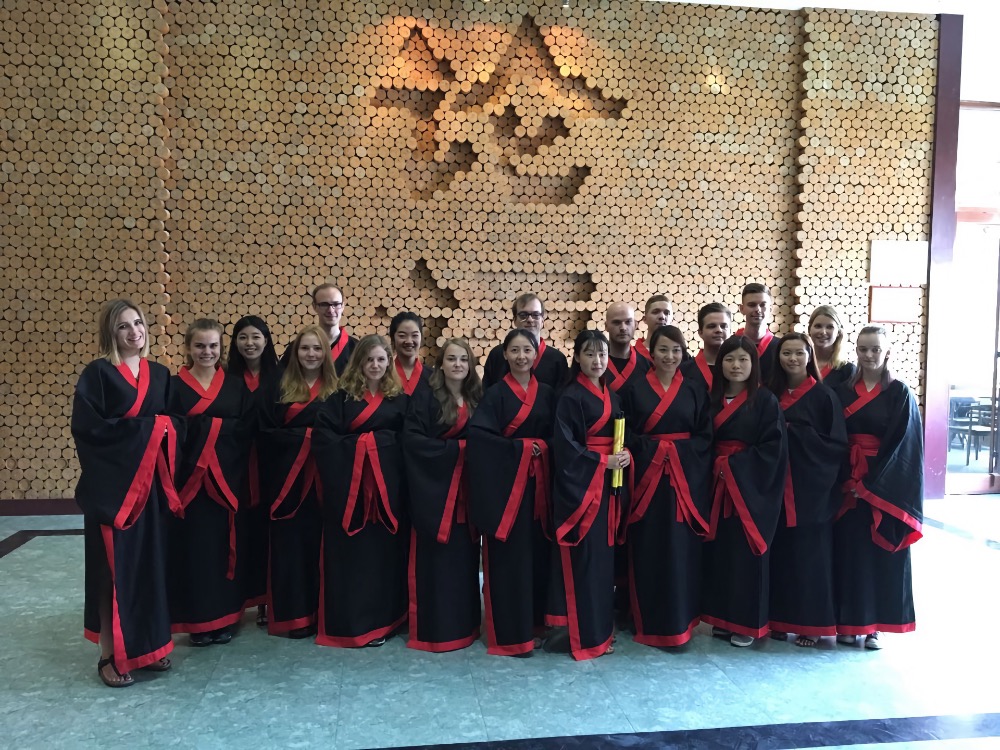
Qufu Excursion
by Rasmus Thy
In June 2017, students who were taking classes on Chinese culture as a part of the ECLC program, had the opportunity to go on a two-days excursion to Qufu, the home city of the great Chinese philosopher Confucius, who is still a very important figure in China today.
We took the train from Beijing Friday morning and arrived in Qufu just before lunchtime. After checking in at our hotel we went to a restaurant where we had the experience of trying the famous Confucius cuisine consisting of a number of dishes that are not only delicious, but also very pleasing for the eye. I’m personally very happy that I had this opportunity, since this kind of food is very different from what I usually come across during my stay in Beijing.
After lunch we took the bus to a place where we had the chance to try on Han clothing, which is the type clothing that Han people have been wearing throughout all dynasties up until the last dynasty Qing. Han clothing is also a topic we have learned about in our culture classes at ECLC, so it was fun to try wearing it for yourself, even though I’m sure that the clothes we wear were far from the best quality Han clothes that you will be able to find.

While still wearing the Han clothes we participated in a simulated traditional ceremony, where we as students, had to pay our respect to our teacher and Confucius. From my understanding, this kind of ceremony was one that students in ancient times had to go through, as a way of formally becoming a pupil or an apprentice to a master. The ceremony included students writing calligraphy, burning incense, bowing and paying respect to our teacher. The ceremony was very formal, and it was interesting to experience how different the teacher-student relationship in traditional China is to the teacher-student relationship we see today.
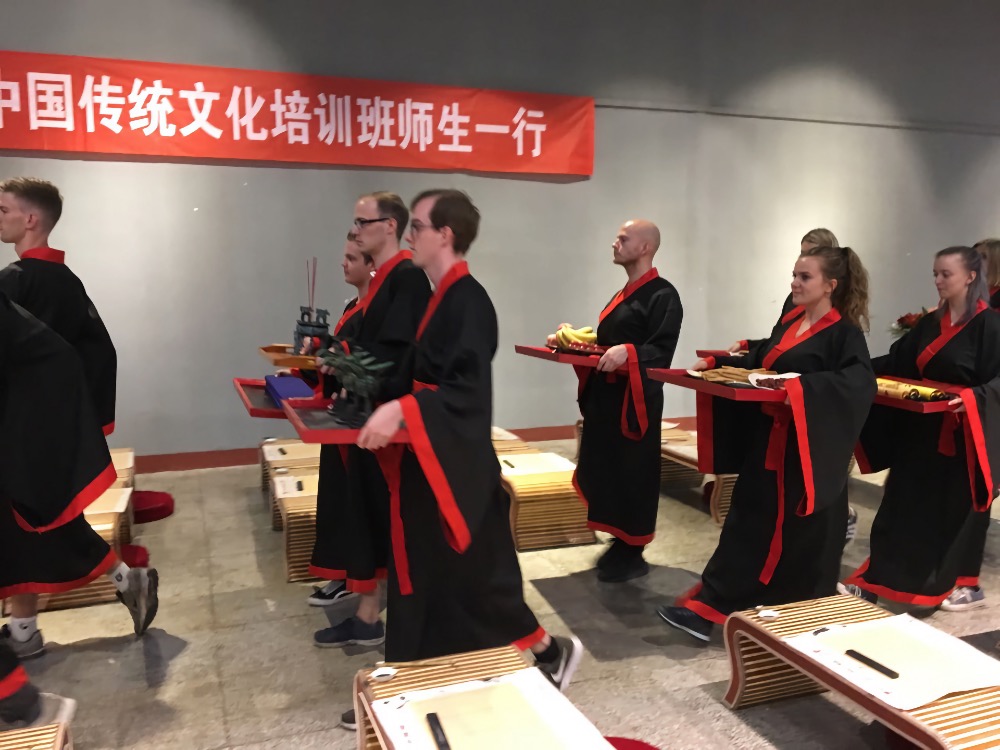

In the evening, our teacher had invited a professor from Peking University to tell us about traditional Chinese painting. Although most of us were not able to understand everything he said, I personally enjoyed the talk a lot, especially because we also had the opportunity to try to paint for ourselves, while the professor was giving instructions on how to do it properly. It was great learning a few simple painting techniques to get a better idea of how traditional Chinese paintings are made and composed. I feel like next time I see a traditional Chinese painting, I will be looking at it differently than I did before this short lecture.
Saturday morning we went to Confucius’ temple, where we had an English-speaking guide showing us around. Since we had learned about traditional Chinese architecture in our culture classes, it was very interesting to see some architecture and traditional buildings with our own eyes. After Confucius’ temple, we drove through Confucius’ family graveyard, which is located in a forest. This is where Confucius as well as his descendants are buried. During the Cultural Revolution the Red Guards put fire to parts of the forest, and even dug up Confucius’ grave and removed his corpse. Although in my opinion it’s a shame what the Red Guards did, it added to the experience, knowing that something like that had happened not that many years ago. The graveyard holds parts of both ancient and recent history.
Saturday afternoon we were taught how to make books the way they did in ancient times and had the chance to try printing with movable type, one of the four great Chinese inventions. This way of printing is something I’ve learned about in my early Chinese history classes, but it wasn’t until I tried it for myself, that I really understood how it works.
Afterwards we got a short lecture on Guqin, which is a traditional seven-stringed plucked instrument that you must be able to play as a real Confucian gentleman. We were told about the Guqin as an instrument and heard it being played for us. Once again we had the opportunity to try it out for ourselves, which was fun, but just as with the Chinese painting, I found out that what might seem very simple is actually incredible difficult.
Saturday evening we took the train back to Beijing, and that was the end of a short but very interesting trip to Qufu. Having stayed in Beijing for a few months, it was nice to get a trip out of town and see something different. Besides the visit to Confucius’ temple, the activities we participated in were all something that I probably wouldn’t have managed to arrange by myself. All in all I had a great trip with my classmates and teachers, and with a good deal of educational value as well.
Qufu Experience
by Julia
Qufu 曲阜 is a city in the Southwest of Shandong province. It is home to 60.000 people and close to Tai Mountain 泰山 which is one of the five holy mountains in China. But why is a town as little as this so important to China? Why is Qufu worth a trip? To answer this question, one must know that Confucianism, Taoism, and Buddhism are the three main beliefs of China. Since Confucius 孔子 was born in Qufu, Qufu is basically the origin of Confucianism. If one wants to understand what Confucius’ hometown is like, where he grew up and where he got buried, one must go to Qufu. Since Confucianism is such a big part of Chinese culture, our culture class teacher Mu Laoshi 穆老师 organized a trip for us. In the following paragraphs, we would like to depict how we spent the trip, where we went, and what we learned.

At nine o’clock in the morning of the June16th 2017 the Danish and German students of culture class, which is part of the ECLC program, met with our four teachers at the Beijing Southern Train Station to take the 高铁 to Qufu. After a two-hour train ride, we arrived in Qufu, Shandong province. A short bus ride later we reached our hotel, where we would spend the night. As soon as we went through the doors, we smelled the fumes of joss sticks that filled the air. A wooden Confucius statue made up the center of the lobby. After having brought our luggage to our rooms, we went out to eat at a Confucian restaurant. Not only were we enjoying a great tasting meal, but also did we learn about etiquette and manners that are deeply anchored in Chinese culture, since Confucius described, what is part of 礼俗 (lǐsú). After lunch, we went on to celebrate a thanking-the-teachers ceremony 拜师 礼. Before the ceremony all of us were given some information what role we should play in the ceremony. Wearing traditional Chinese clothes, one half of the students sat inside the hall, the other half walked down the aisle, following the rhythm of the drummer, carrying lanterns, fruit baskets, flower baskets and other items that belong to a traditional Confucian ceremony. While we were experiencing what the characteristics of a Confucian ceremony are and what it felt like to participate, we had the opportunity to thank our teachers for guiding us through our semester in Beijing, teaching us well, and helping us with any kinds of trouble. Secondly, we experienced a traditional archery presentation 射箭体验 and later, we got the chance to shoot some arrows ourselves. The teachers also discovered their liking of archery and the heat could not stop us from eagerly trying to hit the target. Thirdly, next to the ceremony and the archery experience, the calligraphy lesson 书画体验 was another highlight of the first day. The calligraphy teacher from Beijing University 北京大学 came to Shandong to teach us some basics. After some theoretical explanation, we got the chance to try ourselves. The next day after having breakfast at the hotel, we took a short bus ride to the southern gate of the Confucius temple 孔庙 to see the opening ceremony 开城仪式. The music and the actors, which included dancers and archery men, gave us an idea of what life must have been like in the earlier times. After they finished, we met our tourist guide that would lead us through the temple. The temple is made up of three parts. While walking through the different doors in between, we learned that women must go with the left leg at first, men with the right. The temple also included a little park, where we discovered a group singing and playing traditional Chinese instruments underneath a little pavilion. The woman who was singing was dressed up in traditional Chinese clothes called 汉服. After strolling through the park for a little longer, we left the temple in order to go to Confucius’ tomb 孔林. Since the area was quite big, we took a car to get there. During the ride through the forest, we discovered a lot more of other little tombs and learned that nowadays members of Confucius’ family are still buried around the area of Confucius’ tomb. The second half of the day, we went back to where the ceremony took place. There we had a handicraft lesson 手工体验 and got an insight in the art of binding of a traditional book, the so called 线装书. Except for book binding, we were also given the opportunity to print 活字印刷. After practicing a little while, we heard a private concert of an excellent Qin 古琴 player. Not only did he play the Qin and give us some general information about the instrument and its history, but also were we given the opportunity to try to play ourselves. At the end of the second day we went to the train station to take the train back to Beijing.
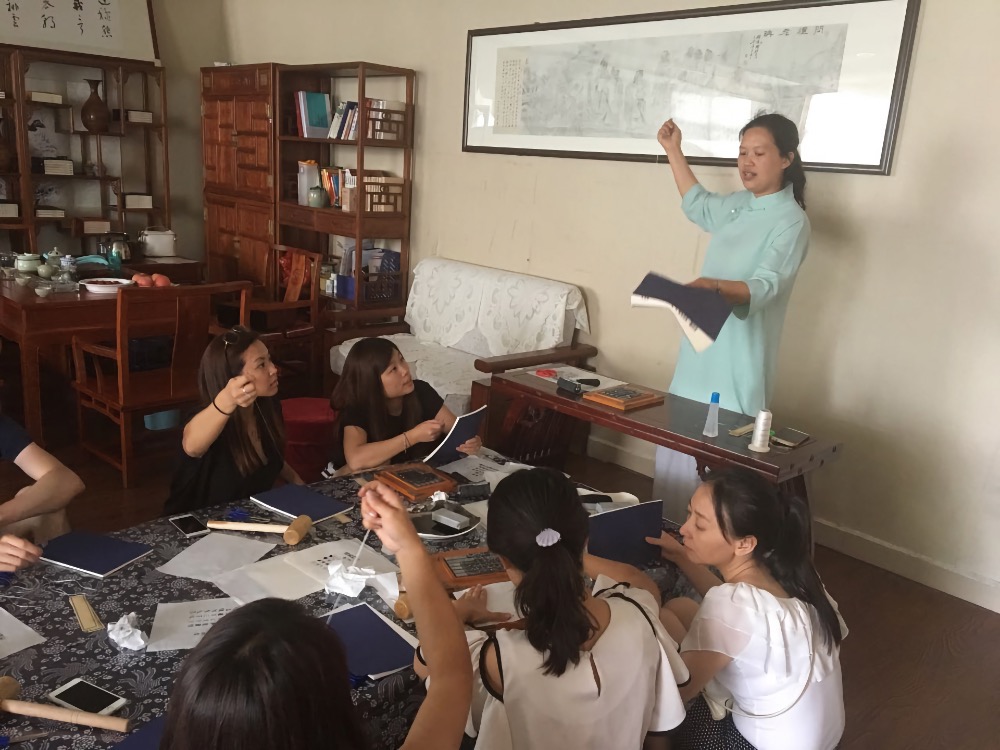
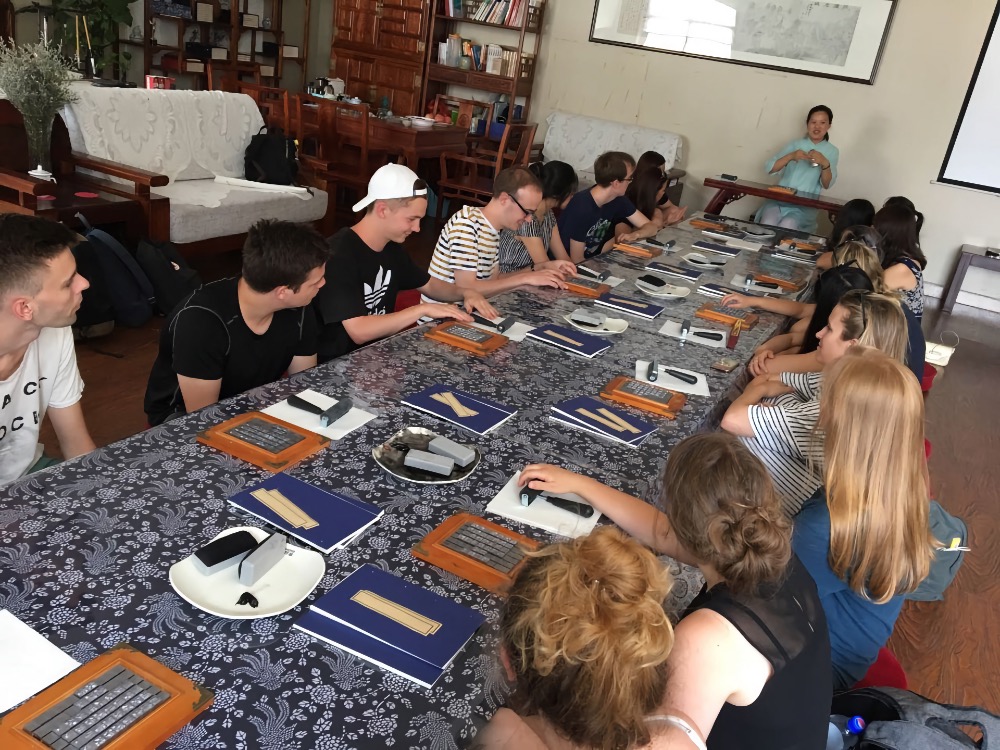
Summarizing the above, we got insights in the Chinese culture at all levels. We enjoyed some typical food, participated in a traditional ceremony, had the opportunity to wear traditional Chinese clothes and saw the birthplace as well as the tomb of Confucius, which is one of the most important aspects in Chinese Culture. All of us students were thankful to have had the chance offered by Mu Laoshi.
Qufu Experience
by Asger Højlund
This year, for the first time in the history of ECLC, a trip to Qufu was arranged for the culture class students. The purpose was to let the students get a hands-on experience with a sample of traditional Chinese arts and crafts, to visit a few of the notable local sights, and to revel in the lingering atmosphere of Confucius’ days of yore.
After having been accommodated at our hotel (in itself reminiscent of a foregone China with its imperial era artefacts and décor), we were brought to a restaurant that, while we were there, was housing a rehearsal dinner for a wedding banquet. The rehearsal, although obnoxiously loud, served as a great form of entertainment as we were gorging on a range of all the best the Shandong province had to offer.

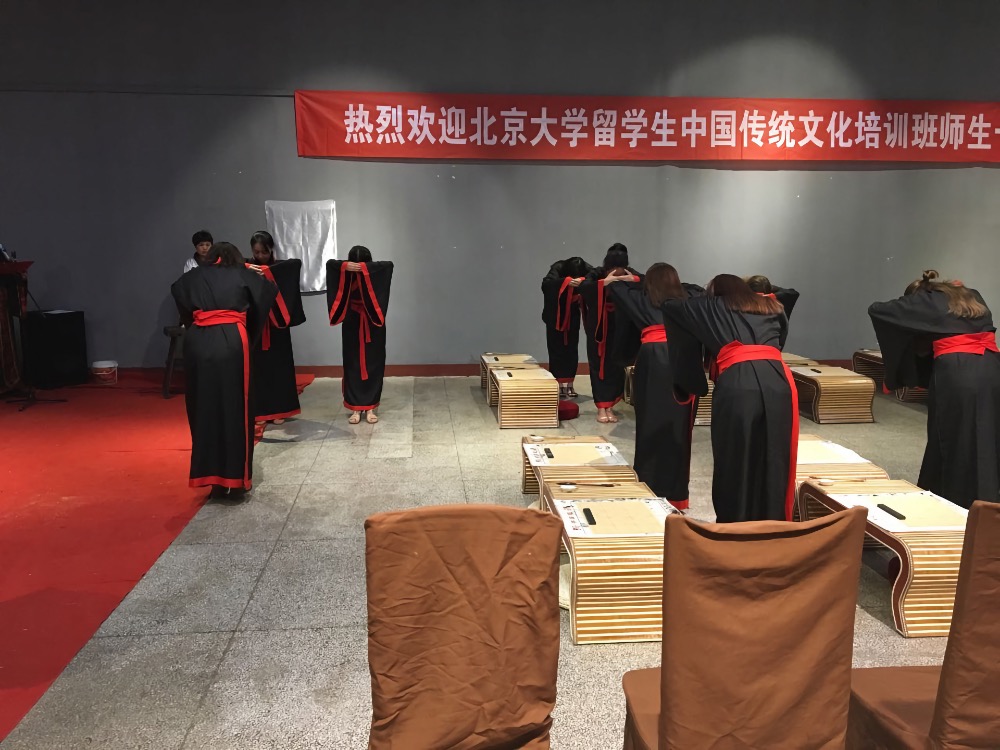
Stuffed on “pig’s elbow” and other delicacies we moved on to the main event of the day: baishili, a Confucius appreciation ceremony, which was held at a Confucius remembrance center. The ceremony entailed wearing traditional hanfu clothes of the shenyi variety, bringing offerings to Confucius, performing a sequence of jugongs (bows), and writing the character 德 in calligraphy.
For the rest of the afternoon we tried our hands on archery with varying degrees of success, had dinner at a nearby restaurant, before finally retreating to our hotel chambers. However, the tight schedule left little room for free time, and we were soon ushered to the bus and back to the Confucius center. There we would be introduced to the art of traditional Chinese painting by an art teacher from Beijing. Having sat through half an hour of lecture of very specialized terminology pertaining to the quality of the brushstrokes, the concentration of the ink, and other aspects of this noble art, that even Mu laoshi at times seemed to have trouble translating, we got the chance to create our own little masterpieces. We were told to mimic our teacher’s every action and get the strokes’ lengths, widths and intersections exactly right. Overall, the experience provided us with a very good insight into the kind of balancing of discipline and creativity that seems to be particular to China.
The next day we watched the opening ceremony of the local Confucius temple, which unfolded in a spectacular flurry of dance and music. Armed with a (sort of) English-speaking guide, we walked through the temple complex, where we would find ourselves among ancient, gnarly trees, enormous tortoise-mounted stone tablets, beautifully decorated buildings and the occasional ayi determined to get herself a few laowai-pictures for the family album. From the temple complex, we continued to another one of the collectively coined “Three Confucian Sites”, The Cemetery of Confucius, which, apart from acting as Confucius final resting place, also contains numerous of his descendants’ graves. Sitting in an oversized golf cart, we followed a narrow road through what felt more like a primeval forest than a cemetery ground. The park has seemingly been left largely uncultivated through the last couple of millennia, and, coupled with the myriad of grave mounds shaping the landscape of the park this creates an eerie and contemplative atmosphere that starkly contrasts the hustle and bustle of the surrounding city.
We returned to theConfucius center later in the day to try our hands on printing and bookbinding (we all got to keep our own book), and after a short intermezzo we were divided into small groups, each group being assigned a guqin, a traditional Chinese string instrument. A local Shandongese musician then gave a lecture on the significance of the instrument and its different features, all of it delivered in an almost unintelligible local dialect. He eventually performed a few songs on the guqin, demonstrating the instrument’s wide range of emotions. With this performance, we concluded our stay in Qufu. After a quick meal, we were once again on the bullet train headed for Beijing, enrichened with a newfound sense of how ancient arts and philosophy continue to contribute to modern Chinese society.
雷木森,《曲阜给我的印象》
我觉得曲阜很好玩儿。我在曲阜的时候参观很多很好玩的名胜古迹,比如孔子的墓地。虽然那个坟墓是空的,但是我还觉得那个地方有一个特别的气氛。很多人还来这地方为拜孔子,这个方面我觉得很有意思。
此外我觉得我们吃的东西非常好吃。我们一到曲阜就去一家很好的饭馆。虽然我对于鱼一般有点挑,但是无论吃鱼,汤还是别的菜,我觉得都非常好吃。
我最喜欢的应该是弹古琴,我们很幸运有一个古琴家来教我们怎么弹古琴,然后我们都可以试试看。从此我决定了,如果我有机会我肯定要买一个古琴,然后在丹麦将中国乐器和西方乐器结合在一起创作音乐。
卢威,《印象最深的是中国画》
我们在曲阜的两天都安排的满满的,所以虽然我的印象中只有这两天,但是,我在曲阜体会传统文化的经历还是很丰富。回想曲阜,周五晚上的绘画课是给我留下最深刻的印象之一。尽管我那时候很累很无聊,尽管我听不清楚老师的话(因为他用的话筒很差),尽管老师用绘画专门的词语,但是我还是觉得他讲的内容特别有意思,只是我有点累,听不清楚老师的声音,听不懂他用的词语,在这种情况下专心地听老师的讲座有点难。
那我为什么觉得他解释那么有意思呢?他介绍了什么?我上这节课之前已经知道中国传统文化,儒释道,都非看重尊重和谐和平衡。在和谐和平衡的想法下画画,这两个想法出现得清清楚楚的,抽象变具体。黑白,浓淡,重轻,湿干,长短,画的时候都要平衡,把这些成分变成和谐的整体印象。这样不同的意境能连起来合在一起。
总的来说,我对这节课感兴趣,因为中国传统文化方方面面都体现了和谐这个主题,但画画的时候,这个想法十分明显。
魏婧,《我加深了对中国传统文化的了解》
初次去曲阜孔子的故乡,让我获得很多有趣的体验,其中让我印象最深刻的是“孔府菜”、拜师礼,以及参观“三孔”。此外,还体验了古代式手工做书,印刷,书画,欣赏古琴等活动。
首先,我们品尝了“孔府菜”,让我大饱口福,因为菜品丰富,花样多姿,而使我印象最深的是鲁壁藏书,圣书香,但我觉得最好吃的是诗礼银杏。此外,菜名都以儒家文化为主题,也让我觉得很有特点。
其次,我们还体验了拜师礼,而这是我这次游学中印象最深的,因为我们换上了汉服,以及真的很认真的排练走位,拜礼等。那个气氛让我觉得拜师是一件非常严肃的仪式,也被人们重视。
最后,我们参观了“三孔”:孔庙,孔府,孔林景区,虽然导游的英语让我有点懵了,但没有影响我看悠久的文化建筑。
总的来说,我觉得这次游览孔子故乡让我更深入的了解孔子对中国文化的影响,以及中国的文化是多么的博大精深。
胡瑶君,《穿汉服让人平和》
第一次去曲阜,孔子的故乡,让我切身感受到了中国传统文化,我们体验的活动也让我更了解了孔子,其中的射箭,拜师礼,吃孔府菜,手工做书及印刷的活动给我留下最深的印象。
穿着汉服拜师礼是一个很难忘的经历。在行拜师礼时,我感觉环境很平和,而且心里也感到平和。此外,穿汉服让人有一种特别的感觉,像人更有平和与高雅的感觉。
此外,自己做书与印刷特别有意思,没想到手工做书并不难,而印刷课需要好的技术。
孔子菜十分精细,色香味形是孔子菜的特征,每道菜色味俱佳。另外,我们还学学习了弹古琴,画画,参观“三孔”。“三孔”指曲阜孔府,孔庙,孔林,而孔府与孔庙的建筑设计与故宫很相像。
于琳达,《去曲阜的经历》
去曲阜的经历给我留下的印象非常好,我为什么这样认为?原因很多,首先,旅游计划安排的很好。又包括曲阜最有趣的景点,又包括各种各样的活动,给学生们机会尝试很多新的东西,譬如射箭,弹古琴,活版印刷等等。我们还跟一位画家学画国画,并举行了一场拜孔仪式,穿着汉服。对我来说,画国画和举行拜孔仪式时我学的最多,而射箭和活版印刷是最有趣。另外,我认为很多活动要是自己去一般都做不到的,所以觉得很幸运有机会尝试这些活动。
其次,“三孔”游学也给了我们很多印象,让我们进一步了解了孔子,作为老师与他所教的知识。
此外,我对我们所吃的饭菜也十分满意,尤其是“孔府菜”品鉴,在色,香,味,形的方面上都很出色。另外,我对酒店也很满意,都安排的很好。
我非常享受这次旅游,将来不会忘记这个经历。

